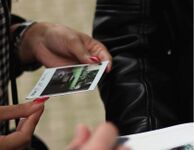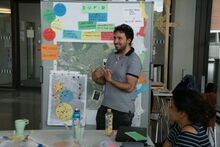LED Workshop Kassel 2017: Difference between revisions
| (23 intermediate revisions by the same user not shown) | |||
| Line 1: | Line 1: | ||
== Kassel | '''Kassel University, June 23 - August 1, 2017''' | ||
<gallery caption=" " widths="220px" heights="150px" perrow="5"> | |||
Image:LED 2017 1.jpg|Meeting the local community in Kassel Nordstadt | |||
Image:LED 2017 2.jpg|Presentation of analysis | |||
Image:LED 2017 3.jpg|Meeting the photo group of Kassel Nordstadt | |||
Image:LED 2017 4.jpg|On the way with members of the photo group | |||
File:LED 2017 13.JPG|Meeting the community in the local mosque | |||
</gallery> | |||
== Workshop Documentation == | |||
* [https://ilias.hfwu.de/goto.php?target=file_19770_download&client_id=hfwu Kassel - Partnering for Landscape Democracy] (free download) | |||
* This booklet documents the Intensive Study Programme held in Kassel from July 23 to August 1, 2017. Feel free to download and share. | |||
== Kassel Nordstadt - A brief Landscape Biography == | |||
'''The spatial context of the 2017 LED intensive study programme''' | '''The spatial context of the 2017 LED intensive study programme''' | ||
| Line 8: | Line 22: | ||
''Prof. Dr. Diedrich Bruns, Kassel University'' | ''Prof. Dr. Diedrich Bruns, Kassel University'' | ||
<gallery caption=" " widths="220px" heights="150px" perrow="5"> | |||
File:LED 2017 14.JPG|Photo voice | |||
Image:LED 2017 5.jpg|Preparing for the visioning chairs method | |||
Image:LED 2017 10.jpg|The local support team: Pia Bültmann and Franziska Bernstein | |||
Image:LED 2017 6.jpg|Group work in the ASL foyer | |||
Image:LED 2017 7.jpg|Group work in the ASL foyer | |||
</gallery> | |||
== Process Biography of the Kassel Intensive Study Programme == | == Process Biography of the Kassel Intensive Study Programme == | ||
In advance of running the 2017 Online Seminar and the Kassel Intensive Study Programme (ISP), the LED team met several times in virtual team rooms and face-to-face in Kassel. Learning from the first year of the LED project, the team adjusted the seminar structure and content, and it | In advance of running the 2017 Online Seminar and the Kassel Intensive Study Programme (ISP), the LED team met several times in virtual team rooms and face-to-face in Kassel. Learning from the first year of the LED project, the team adjusted the seminar structure and content, and it | ||
| Line 20: | Line 40: | ||
''Prof. Dr. Diedrich Bruns, Kassel University'' | ''Prof. Dr. Diedrich Bruns, Kassel University'' | ||
<gallery caption=" " widths="220px" heights="150px" perrow="5"> | |||
Image:LED 2017 8.jpg|Group work in the ASL foyer | |||
<gallery caption=" " widths=" | Image:LED 2017 9.jpg|Group work in the ASL foyer | ||
Image:LED 2017 | Image:LED 2017 11.jpg|Group work in the ASL foyer | ||
Image:LED 2017 | Image:LED 2017 12.jpg|Preparing the final presentation | ||
Image:LED 2017 | File:LED 2017 15.JPG|The LED workshop team 2017 | ||
Image:LED 2017 | |||
</gallery> | </gallery> | ||
Latest revision as of 12:50, 14 January 2021
Kassel University, June 23 - August 1, 2017
Workshop Documentation
- Kassel - Partnering for Landscape Democracy (free download)
- This booklet documents the Intensive Study Programme held in Kassel from July 23 to August 1, 2017. Feel free to download and share.
Kassel Nordstadt - A brief Landscape Biography
The spatial context of the 2017 LED intensive study programme
Centrally located in Europe, at a crossroad of commerce and trade, industrial development came early to Kassel. Starting in the first decade of the 19th century, entrepreneurs striving for success founded railroad, engineering, textile and trading companies outside of the old city. Offering good transportation access, the route to the North-West (to “Holland”) is where the first factories where built. “Nord-Holland” and the “Holländische Straße” became to be synonymous with booming business, but also with “smoke and soot” and, particularly during wartimes, with devastating destruction. Urban development sped up in several waves, first between 1860 and the turn of the century, again before WW II, and then during the post-war boom years. Companies built houses for workers, administrators and their families along new streets and infrastructure. After retirement, and during periods of economic slowdown, people moved out and so called “guest workers” moved in. In their families, unemployment hit hardest. Compared with the Kassel average, rents in “Nord” stayed low and houses in poor repair. Noise and dust increased as traffic along the Holländische Straße grew. The “Nordstadt” now became to be synonymous with low income, and with (vaguely defined) “social problems”.
During the 1960s and 70s, industrial production and transportation infrastructure relocated and large tracts of land became available. Warehouses, gasoline stations, fast food, supermarkets and building supply stores took advantage of cheap vacant plots at the edge of town, while educational facilities such as the university, schools, community centres, etc. developed closer to the City. Services such as bookstores, small food stores, restaurants and followed suit. An invisible line emerged dividing the “Nordstadt” into two parts, the “Vordere Nordstadt” in front and the rest behind the line. Many ethnically different groups live in both parts but the mix has two different images: a positive one of enriching cultural pluralism and collaboration, and a negative one where various groups a struggling between integration and clinging to their particular identities. This division has led to many disparities and challenges that are the starting point for the next generation of urban and social regeneration.
Prof. Dr. Diedrich Bruns, Kassel University
Process Biography of the Kassel Intensive Study Programme
In advance of running the 2017 Online Seminar and the Kassel Intensive Study Programme (ISP), the LED team met several times in virtual team rooms and face-to-face in Kassel. Learning from the first year of the LED project, the team adjusted the seminar structure and content, and it started advertising and recruiting students for the seminar and for the IP. To help participants to get familiar with “Kassel-Nordstadt”, the 2017 IP area, before arriving in Kassel, the team introduced two online meetings as a new IP feature. Student participants discussed potential landscape democracy challenges using air photos and later, after visiting the site in person, checked these assumptions against realities they met on the ground. They also had prepared questions about the Nordstadt that they asked local stakeholders, starting on day one of the workshop.
The Kassel IP team began identifying and visiting with local stakeholders as early as January and February 2017. Speaking with key stakeholders proved to be a good way of learning about actor and stakeholder constellations in the Nordstadt early enough for building trust with a larger number of people who then agreed to get involved with the LED project themselves. During the Kassel University summer-term, the Landscape Planning department ran a student project “Nordstadt Landscape & Power”. Twenty-three town and landscape architecture students interviewed Nordstadt actors and stakeholders, such as a senior citizen group, a migrant women association, and an ethnically mixed football club. They also mapped evidence and symbols of power in the landscape. In a feedback process, the Kassel team shares results from the summer-term project and from the Kassel IP with Nordstadt communities.
Prof. Dr. Diedrich Bruns, Kassel University














